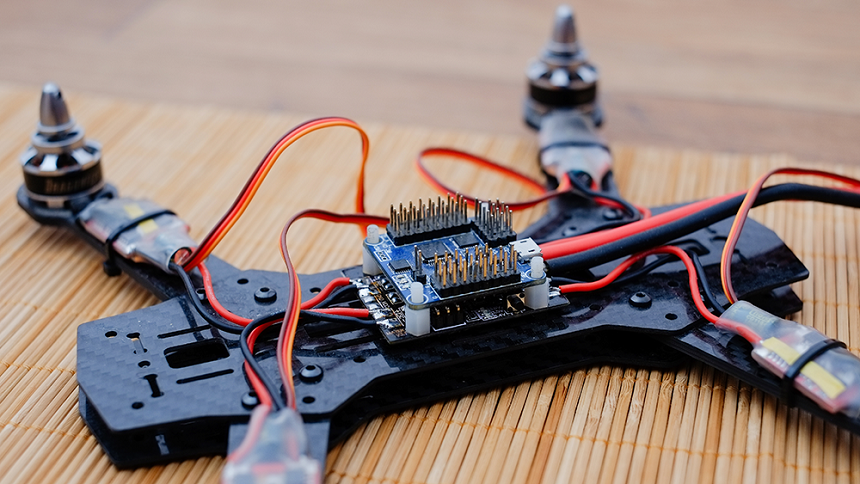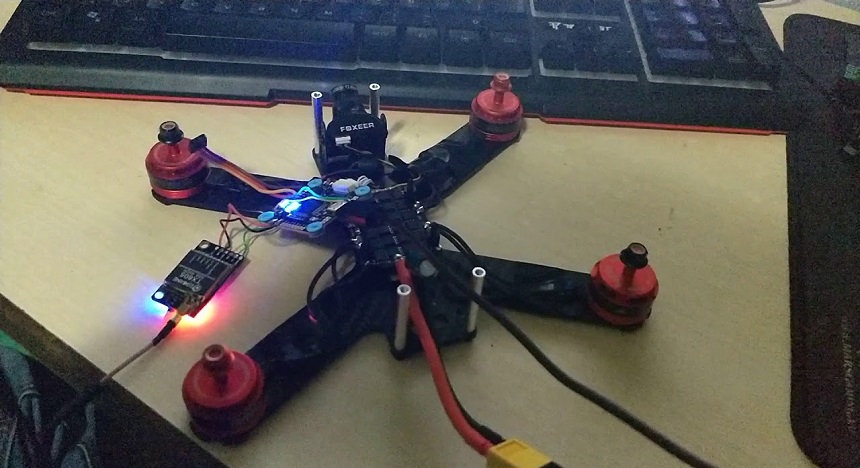To the frustrations of many, the infamous drone flip during takeoff is pretty common. If you trawl through drone forums on a regular basis, you’ll often see complaints of a drone flipping on takeoff, and they’re usually accompanied by lots of different suggestions. Unfortunately, that’s because there are so many different reasons why this might be happening! If it’s happening to your drone, it’s simply a case of trial and error to fix the issue. It’s usually a case that one of the propellers happens to be rotating at a higher or lower speed than the others, and there are many reasons why this occurs. If you’re using a VR drone, for example, it’s important flipping doesn’t happen! As we know how frustrating this can be, we’ve put them all into one handy article for you! So, whether you’re an experienced drone builder or it’s your first, you can whittle down the reasons for your drone flipping and get it fixed asap.

You might see drones as a new thing, but they’ve been around a lot longer than you might think. Despite this, it’s still easy to experience issues like flipping.
There isn’t just one reason for this flipping, but if we talk about the physics of flight Trusted Source A Brief History of Drones | Imperial War Museums The first pilotless vehicles were built during the First World War but drones now have many functions. www.iwm.org.uk , it means that there is some sort of thrust imbalance. Thrust Trusted Source NASA's Do-It-Yourself Podcast: Rocket Science NASA No matter the size, all rockets must have a body, a nose cone, fins and a propellant system. The body is the main section of the rocket. This section holds many of the electronics needed to control large rockets. The aerodynamic shape of the nose cone helps prevent air from slowing the rocket. The fins help guide the rocket to fly straight. Finally, the propellant system includes a mixture of fuel and a chemical called an “oxidizer” that gives off oxygen. The fuel and oxidizer burn together to launch the rocket off the ground. www.nasa.gov occurs when the propellers push the air down to give lift. If one propeller is going faster or slower than the others, it will generate a different amount of lift and create an imbalance. If you have a stunt drone, you really need things to balance perfectly! Here are the reasons why this might happen and what you can try.
The first thing to check is whether or not the controller is mounted correctly and with the right orientation. There should be some kind of arrow or marking on your drone’s flight controller that indicates where flight forward is. It is possible to change the configuration in your flight controller software, so make sure that you have checked your flight controller markings so that they match up with the software’s expected orientation.
Another reason for flipping could be the motor assignment. To check and resolve this problem, remove all of the props and check that each motor is connected and assigned properly. In your software, choose the motor control and use the slider to ramp each motor up individually. This will mean you can get that each motor slider corresponds to the one that’s turning on your drone. If you want to determine the spin direction, simply apply a small piece of tape around the threads on the motor, and this will highlight the direction.
As we mentioned above, sticking a piece of tape onto the motor thread will help you determine the direction it’s spinning in. You should be able to see a graphic in your software that shows you which way each motor should spin. Use the tape trick to ensure that each one is going in the right direction.
Your ESC ( Electronic Speed Controller Trusted Source Electronic Control - an overview, ScienceDirect Topics Modern electronic controls use analog semiconductor components to effect control logic. Several electronic controllers are commonly packaged into a single device that can handle all of the functions of a specific application such as control of a single zone air handler. Like pneumatic controls, electronic controls are being replaced by direct digital controls. www.sciencedirect.com ) needs to be following the correct protocol. If this is not properly configured, you might find it rebooting with the higher power, which can cause the flipping issue.
You need to make sure that all of your prop nuts are not loose. Check each one individually and make sure the propellers aren’t free spinning when the motors are turning.
A properly mounted flight controller is essential. If it is too loose, it will vibrate. If it is too tight, it can also cause issues too. If you feel this is a problem for your drone, you can use isolation dampers to prevent or reduce this issue.
Just like the prop nuts, the motor screws should be checked for tightness. These need to be checked regularly because the vibrations can easily loosen the screws over time. You can use a thread lock that will prevent your motor screws from becoming loose. The thread lock is like glue, but it looks and feels more like paint or oil.
Surprisingly, this is common and easily done. As all props are directional Trusted Source How Drones Work | HowStuffWorks Although “drone” is the most common term, these flying machines are also often called UAVs (unmanned aerial vehicles). Although government and military agencies were among the first to explore drones for their warfare capabilities, these winged devices are now also marketed to kids, teenagers, RC plane hobbyists, photographers, videographers, farmers and just about anyone who can benefit from a viewpoint in the skies around them. science.howstuffworks.com , you need to make sure that your clockwise props are on a clockwise motor and your counter-clockwise props are on counter-clockwise motors. AS we’ve already mentioned, your software program will show you an image of the direction of each motor and prop. Each drone is different, too, so don’t presume that your new drone will be the same as the previous one. If you do get the prop placement wrong, you’re pretty much guaranteed to have a flipping drone. Other things to check with this include:
Another reason for drones flipping is due to a misconfigured transmitter Trusted Source How do antennas and transmitters work? - Explain that Stuff A transmitter is a different kind of antenna that does the opposite job to a receiver: it turns electrical signals into radio waves so they can travel sometimes thousands of kilometers around the Earth or even into space and back. Antennas and transmitters are the key to virtually all forms of modern telecommunication. www.explainthatstuff.com . You need to check that your transmitter inputs are the same as those on your software program. When you set up your drone for the first time, it can sometimes be reversed.
Generally speaking, your drone will have four screws attaching the motor to its frame. You need to check the continuity between the motor windings and the screws. If there is an issue, you can cause all sorts of unpredictable problems, including flipping. Do watch out though, as the screws can become hot to the touch after use.
Typically, the screw for the mount will be 2mm longer than the thickness of your drone’s frame. So, if your drone’s frame is 3mm, the screw should be 5mm. If the frame is 4mm, the screw should be 6mm, and if the frame is 5mm, the screw should be 7mm.

If your drone has had a recent crash, you’ll need to check the Electronic Speed Controllers in your software program to ensure that they are spinning.
Try using the controller for the main throttle, as this will let you see and compare each one as it spins. Don’t forget to remove the props first! If the ESC or motor is faulty, this will certainly be a cause for the drone to flip – especially if you notice the drone always flipping in the same direction each time. If this fixes the problem, you’ll have no problems adding on a camera like this one to your drone.
If none of our suggestions above help solve the problem, then you might have an issue with the flight controller gyro. Your drone’s flight controller is just like any circuit board, and you’ll find similar ones in your laptop processor or desktop motherboard. Essentially, the flight controller is your drone’s brain; this small box is full of software and intelligent electronics, and it controls and monitors everything your drone does. If you have a fault with this, you might have to consider a flight controller replacement or a new drone. This mini combo is a great investment that you might want to consider.
Hopefully, at least one of these fixes has worked for your drone. Unfortunately, as a drone owner, you’re going to have to up your expertise in all things to do with drones and how they work, the science behind them, and their mechanics. Owning a drone isn’t just about having fun, but the fun you will have! What’s more, it’s quite satisfying to fix problems yourself. So, if your drone flipping on takeoff has been resolved, give yourself a pat on the back and consider yourself an up-and-coming drone fixing expert! However, if you are fed up with propellers and would like to try something new, why not try a fixed-wing drone? There are also some reasonably priced drones around nowadays if it is time for a replacement.